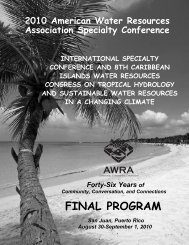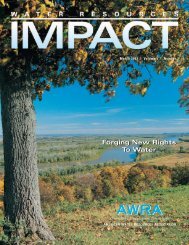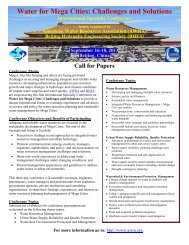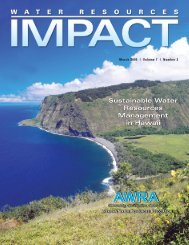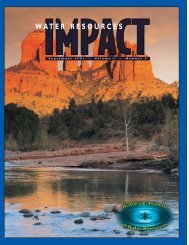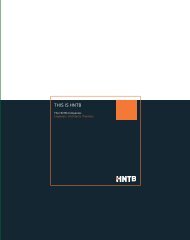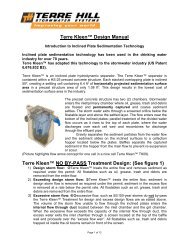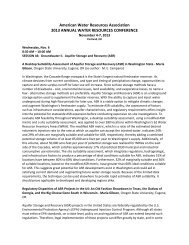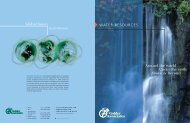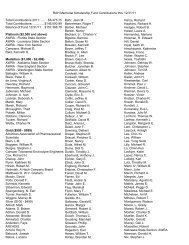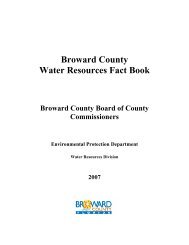N ovember 2 0 0 0 ⢠V olume 2 ⢠N umber 6 - American Water ...
N ovember 2 0 0 0 ⢠V olume 2 ⢠N umber 6 - American Water ...
N ovember 2 0 0 0 ⢠V olume 2 ⢠N umber 6 - American Water ...
You also want an ePaper? Increase the reach of your titles
YUMPU automatically turns print PDFs into web optimized ePapers that Google loves.
▲ AWRA Business . . . cont’d.<br />
Portland Conference a Huge Success!<br />
AWRA International Conference on Riparian Ecology<br />
and Management in Multi-Land Use <strong>Water</strong>sheds<br />
August 28-31, 2000<br />
Reported by<br />
Parker J. Wigington, Jr., Conference Chair<br />
Richard A. Engberg, AWRA Technical Specialist<br />
One of the best technical meetings I have ever attended.<br />
This was the comment of the newest member of AWRA<br />
who joined at the conclusion of the 2000 Summer Specialty<br />
Conference. During August 28-31, 560 people from<br />
around the world gathered together to share knowledge<br />
and to learn about riparian areas. More than 200 oral<br />
and poster presentations provided insights into the ecological,<br />
social, and economic aspects of riparian function<br />
and management.<br />
Riparian areas are vital interfaces between terrestrial<br />
and aquatic ecosystems. They exert strong influences on<br />
stream environments and serve as important habitat for<br />
plant and animal species. Although management efforts<br />
are increasing, knowledge of the integrated function of riparian<br />
areas in multi-land use watershed is still quite<br />
limited. Increased knowledge of this function was the<br />
purpose of the Conference.<br />
The Conference featured 106 platform papers and 87<br />
poster presentations. Six commercial exhibitors also were<br />
in attendance. The platform papers were presented over<br />
three days during concurrent sessions that were extremely<br />
well attended. Posters were displayed during the<br />
first two days of the Conference.<br />
Paul Risser from Oregon State University and Henri<br />
Decamps from Centre National de la Recherche Scientifique<br />
in France started the Conference with keynote<br />
talks that stressed the importance of the human dimensions<br />
of riparian management. Dr. Risser’s topic was “Riparian<br />
Corridors – How Many Practical Answers Do We<br />
Have? and Dr. Decamps’ topics was “Accounting for Cultural<br />
Preferences and Desires in Riparian Ecology and<br />
Management.” On the second day of the Conference,<br />
Joan Nassauer from the University of Michigan continued<br />
the theme of the importance of the human dimension<br />
of riparian management during her plenary talk entitled<br />
“Ecological Innovation: Placing Familiar Expectations in<br />
New Landscape Patterns.” David Correll, with the Smithsonian<br />
Environmental Research Center, focused on an<br />
important riparian function during the final plenary talk,<br />
“The Current Status of Our Knowledge of Riparian Buffer<br />
<strong>Water</strong> Quality Functions.”<br />
A wide range of multi-disciplinary topics were covered<br />
during the 27 concurrent sessions and in the poster<br />
session. Concurrent topics included: hydrologic flowpaths,<br />
western ecosystems and rangelands, social<br />
aspects of riparian management, water quality buffers,<br />
vegetation – water interactions, temperature, channels –<br />
geomorphology, watersheds, ecological function, urban<br />
and built-up land, assessment, large woody debris,<br />
ecosystem trajectories, fish in multi-land use settings,<br />
restoration principles and methods, agriculture and<br />
stream condition, forest riparian areas, birds and terrestrial<br />
vertebrates, and the Willamette River Basin. The<br />
poster session had many excellent presentations and allowed<br />
more in-depth interactions between presenters and<br />
the audience than was possible in the oral sessions.<br />
One of 87 Outstanding Posters Displayed at the Conference.<br />
The oral and poster presentations culminated with a<br />
synthesis session on Wednesday afternoon. Judy Meyer<br />
from the University of Georgia, Tony Prato from the University<br />
of Missouri, and Mark Hill with Ecosystem Sciences<br />
in Boise, Idaho, provided opening remarks about<br />
future directions for riparian management, restoration,<br />
and research in multi-land use watersheds. A period of<br />
lively and wide ranging questions and comments from the<br />
audience followed. Although it is impossible to summerize<br />
this session in a few sentences, the presentations and<br />
discussions emphasized the importance of multidisciplinary<br />
approaches to riparian research, restoration,<br />
and management.<br />
A Welcoming Networking Reception was held for all<br />
attendees Monday evening and a Conference Luncheon<br />
was held on Wednesday. Two busloads of attendees enjoyed<br />
a dinner and the scenery at Multnomah Falls Lodge<br />
on Tuesday evening. The last event of the Conference was<br />
an all-day field trip in the Willamette River Basin of Oregon.<br />
Eighty-six people made visits to urban, agricultural,<br />
and forested sites across the basin to learn about riparian<br />
management issues in each of these land use settings.<br />
An e-mail/website survey conducted following the<br />
Conference received responses from 140 attendees. Seventy<br />
percent indicated that the Conference was their first<br />
AWRA meeting. Overwhelmingly, the primary reason for<br />
attending was the timely topic. A total of 85 percent of the<br />
respondents found the presentations excellent-good. (See<br />
the following page for an order form for a copy of the Proceedings<br />
from this meeting.)<br />
❖ ❖ ❖<br />
30 • <strong>Water</strong> Resources IMPACT N<strong>ovember</strong> • 2000



